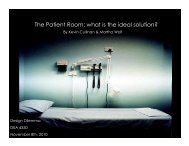The role of physical design and informal communication
The role of physical design and informal communication
The role of physical design and informal communication
Create successful ePaper yourself
Turn your PDF publications into a flip-book with our unique Google optimized e-Paper software.
opportunities for <strong>informal</strong> learning <strong>and</strong> graduate nurse competency levels?” While we<br />
expected that the prime source <strong>of</strong> <strong>informal</strong> learning for the GN would be with more<br />
experienced RNs, in fact interactions with nursing assistants were highly valued.<br />
Specifically, when the GN was asked questions by the nursing assistants, it forced her<br />
to assume a teaching <strong>role</strong> on the spot which facilitated her own learning <strong>and</strong> increased<br />
her confidence. <strong>The</strong> type <strong>of</strong> learning that the GN experienced can be termed<br />
“reactive” or “opportunistic” learning as described by Eraut (2004). According to<br />
Eraut, reactive learning is near-spontaneous <strong>and</strong> occurs in the middle <strong>of</strong> action, when<br />
there is little time to think. This definition closely approximates the type <strong>of</strong> situation<br />
that occurred when a nursing assistant unexpectedly approached the GN with a<br />
question. This is in contrast to “deliberative” learning, where there is a definite<br />
learning goal <strong>and</strong> time is set aside for acquiring new knowledge (Eraut, 2004). Henry<br />
B. Slotnick, <strong>of</strong> the University <strong>of</strong> Wisconsin Medical School in Madison, conducts<br />
research on how physicians learn. Slotnick (2004) argues that “you never know<br />
anything as well as you do after you’ve taught it to someone else.” He describes a<br />
situation in which someone is asked a question unexpectedly <strong>and</strong> is required to reflect<br />
more carefully on what is taking place in order to respond to the interesting situation<br />
that has been created. This kind <strong>of</strong> reflection in the heat <strong>of</strong> the action results in new<br />
insights for both the “teacher” <strong>and</strong> the “student.” This concept can be used to explain<br />
why the GN believed she learned so much from answering the questions <strong>of</strong> nursing<br />
assistants.<br />
Another interesting finding regarding the GN learning experience was that<br />
there was perhaps less interaction with the Orientor than one would expect. In fact,<br />
interactions involving “knowledge transfer” occurred in roughly equal amounts with<br />
the Orientor <strong>and</strong> other RNs. This came as a bit <strong>of</strong> a surprise since the <strong>role</strong> <strong>of</strong> the<br />
Orientor was to be the <strong>design</strong>ated mentor <strong>and</strong> guide for the GN during orientation. In<br />
112







